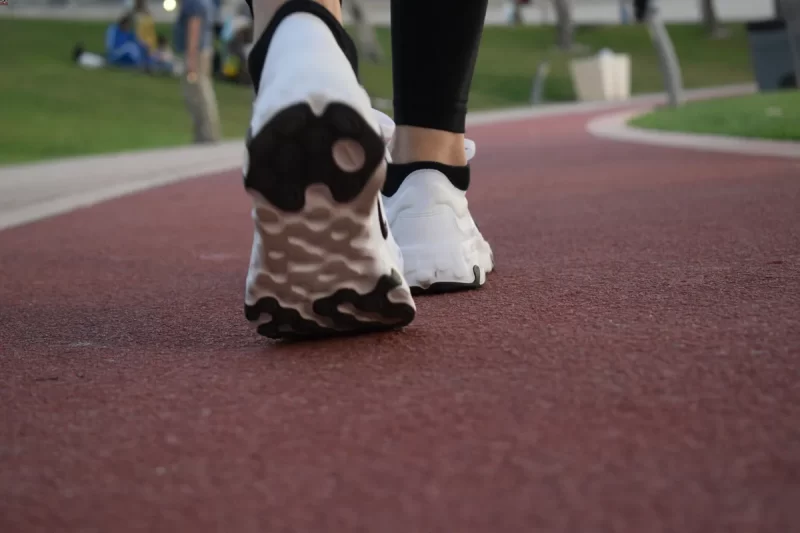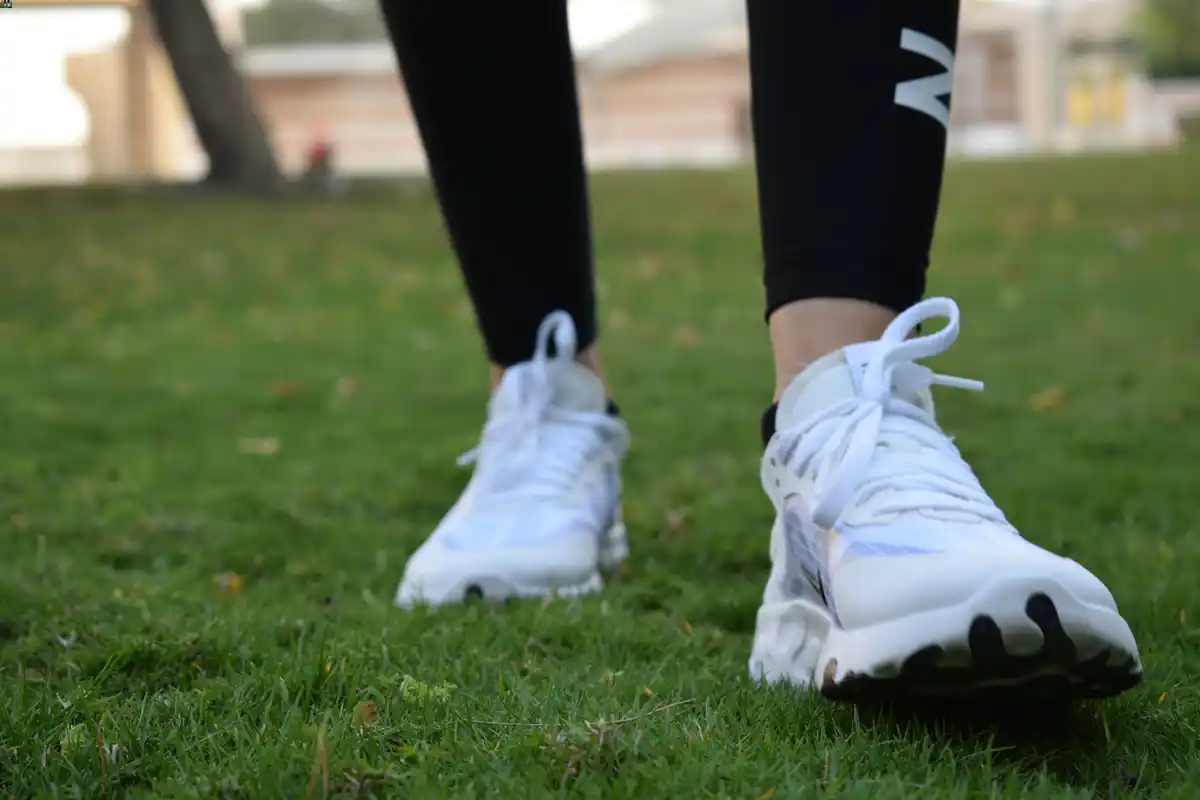On average, 10,000 steps are 4.1-4.4 miles. This estimate mainly depends on your height and gender, but your walking speed, weight, and age can also affect it to a lesser extent. The range I provided is for men (4.4 miles) and women (4.1 miles) of average heights, 5’7″ and 5’3″, respectively. The taller you are, the longer the distance covered is.
The following tables show what 10,000 steps are equivalent to in miles depending on your height and gender. I estimated step length from height and then used it to find how many miles 10,000 steps are.
Men: (Scroll down for women)
| Height | Distance for 10,000 steps (miles) |
|---|---|
| 5’2″ (157 cm) | 4.06 |
| 5’3″ (160 cm) | 4.13 |
| 5’4″ (163 cm) | 4.19 |
| 5’5″ (165 cm) | 4.26 |
| 5’6″ (168 cm) | 4.32 |
| 5’7″ (170 cm) | 4.39 |
| 5’8″ (173 cm) | 4.45 |
| 5’9″ (175 cm) | 4.52 |
| 5’10” (178 cm) | 4.58 |
| 5’11” (180 cm) | 4.65 |
| 6’0″ (183 cm) | 4.72 |
| 6’1″ (185 cm) | 4.78 |
| 6’2″ (188 cm) | 4.85 |
| 6’3″ (191 cm) | 4.91 |
Women: (Scroll up for men)
| Height | Distance for 10,000 steps (miles) |
|---|---|
| 4’9″ (145 cm) | 3.72 |
| 4’10” (147 cm) | 3.78 |
| 4’11” (150 cm) | 3.85 |
| 5’0″ (152 cm) | 3.91 |
| 5’1″ (155 cm) | 3.98 |
| 5’2″ (157 cm) | 4.04 |
| 5’3″ (160 cm) | 4.11 |
| 5’4″ (163 cm) | 4.17 |
| 5’5″ (165 cm) | 4.24 |
| 5’6″ (168 cm) | 4.3 |
| 5’7″ (170 cm) | 4.37 |
| 5’8″ (173 cm) | 4.43 |
| 5’9″ (175 cm) | 4.5 |
| 5’10” (178 cm) | 4.56 |
| 5’11” (180 cm) | 4.63 |
How many calories do 10,000 steps burn?
On average, 290-380 calories are burned by walking 10,000 steps. The calories burned depends on your weight, height, and walking speed.
The tables below show how weight and height affect the calories burned by walking 10,000 steps. To see the effect of walking speed, check my other post, which goes into more detail.
Men: (Scroll down for women)
| Weight | Height | Calories burned walking 10,000 steps |
|---|---|---|
| 132 lb. (60 kg) | 170 cm (5’7″) | 351 |
| 175 cm (5’9″) | 367 | |
| 180 cm (5’11”) | 384 | |
| 143 lb. (65 kg) | 170 cm (5’7″) | 366 |
| 175 cm (5’9″) | 383 | |
| 180 cm (5’11”) | 399 | |
| 154 lb. (70 kg) | 170 cm (5’7″) | 382 |
| 175 cm (5’9″) | 398 | |
| 180 cm (5’11”) | 416 | |
| 165 lb. (75 kg) | 170 cm (5’7″) | 397 |
| 175 cm (5’9″) | 414 | |
| 180 cm (5’11”) | 432 | |
| 176 lb. (80 kg) | 170 cm (5’7″) | 412 |
| 175 cm (5’9″) | 430 | |
| 180 cm (5’11”) | 448 | |
| 187 lb. (85 kg) | 170 cm (5’7″) | 427 |
| 175 cm (5’9″) | 445 | |
| 180 cm (5’11”) | 464 | |
| 198 lb. (90 kg) | 170 cm (5’7″) | 442 |
| 175 cm (5’9″) | 461 | |
| 180 cm (5’11”) | 480 | |
| 209 lb. (95 kg) | 170 cm (5’7″) | 457 |
| 175 cm (5’9″) | 476 | |
| 180 cm (5’11”) | 496 | |
| 220 lb. (100 kg) | 170 cm (5’7″) | 473 |
| 175 cm (5’9″) | 492 | |
| 180 cm (5’11”) | 512 | |
| 243 lb. (110 kg) | 170 cm (5’7″) | 503 |
| 175 cm (5’9″) | 523 | |
| 180 cm (5’11”) | 544 | |
| 265 lb. (120 kg) | 170 cm (5’7″) | 533 |
| 175 cm (5’9″) | 555 | |
| 180 cm (5’11”) | 576 | |
| 287 lb. (130 kg) | 170 cm (5’7″) | 564 |
| 175 cm (5’9″) | 586 | |
| 180 cm (5’11”) | 608 |
Women: (Scroll up for men)
| Weight | Height | Calories burned walking 10,000 steps |
|---|---|---|
| 110 lb. (50 kg) | 160 cm (5’3″) | 273 |
| 165 cm (5’5″) | 285 | |
| 170 cm (5’7″) | 297 | |
| 121 lb. (55 kg) | 160 cm (5’3″) | 282 |
| 165 cm (5’5″) | 295 | |
| 170 cm (5’7″) | 307 | |
| 132 lb. (60 kg) | 160 cm (5’3″) | 292 |
| 165 cm (5’5″) | 305 | |
| 170 cm (5’7″) | 317 | |
| 143 lb. (65 kg) | 160 cm (5’3″) | 302 |
| 165 cm (5’5″) | 315 | |
| 170 cm (5’7″) | 328 | |
| 154 lb. (70 kg) | 160 cm (5’3″) | 312 |
| 165 cm (5’5″) | 325 | |
| 170 cm (5’7″) | 338 | |
| 165 lb. (75 kg) | 160 cm (5’3″) | 321 |
| 165 cm (5’5″) | 335 | |
| 170 cm (5’7″) | 349 | |
| 176 lb. (80 kg) | 160 cm (5’3″) | 331 |
| 165 cm (5’5″) | 345 | |
| 170 cm (5’7″) | 359 | |
| 187 lb. (85 kg) | 160 cm (5’3″) | 341 |
| 165 cm (5’5″) | 355 | |
| 170 cm (5’7″) | 369 | |
| 198 lb. (90 kg) | 160 cm (5’3″) | 351 |
| 165 cm (5’5″) | 365 | |
| 170 cm (5’7″) | 380 | |
| 220 lb. (100 kg) | 160 cm (5’3″) | 371 |
| 165 cm (5’5″) | 385 | |
| 170 cm (5’7″) | 401 | |
| 243 lb. (110 kg) | 160 cm (5’3″) | 390 |
| 165 cm (5’5″) | 406 | |
| 170 cm (5’7″) | 421 | |
| 265 lb. (120 kg) | 160 cm (5’3″) | 410 |
| 165 cm (5’5″) | 426 | |
| 170 cm (5’7″) | 442 | |
| 287 lb. (130 kg) | 160 cm (5’3″) | 429 |
| 165 cm (5’5″) | 446 | |
| 170 cm (5’7″) | 463 |
How many steps a day to lose weight

The number of steps a day to lose weight is equivalent to the required calorie deficit. For example, you have to walk 13,000-17,000 steps at a brisk pace of 3.5 mph (5.6 km/h) to burn 500 calories. Suppose you consume food equivalent to your daily basal metabolic rate (BMR). In that case, you have to walk 13,000-17,000 steps for a calorie deficit of 500 calories. You can theoretically lose 1 kg (2.2 lb.) of fat with that calorie deficit within 16 days. For more estimates on losing a kilogram of body weight, please read my other article on the topic.
Although exercise is recommended for everyone, limiting your food intake might be easier than walking to create a calorie deficit. However, many people have a healthy appetite and tend to give up on their weight loss goals if they are constantly hungry. If this sounds like you, putting in those extra steps might be your best bet. If you don’t mind cutting your calorie intake, a diet might be the better option for people with limited time.
Studies have shown that dieting can produce weight loss results that are far better than those from exercising alone. For example, a meta-analysis of 25 years of research showed that diets resulted in an average weight loss of 23.6 lb. (10.7 kg) in 15 weeks (Source). Exercise resulted in an average weight loss of only 6.4 lb. (2.9 kg). Combining a diet with an exercise program might be the best overall approach since those saw an average weight loss of 24.2 lb. (11 kg). Those who exercised also managed to keep off more of their lost weight after one year (Source).
How far is 10,000 steps?
On average, 10,000 steps are about 6.6-7.1 kilometers. This distance depends on your height and gender, but your walking speed, weight, and age can also affect it. Since men are, on average, taller than women, the distance they cover in 10,000 steps is longer. The range, therefore, corresponds to 7.1 km for men (170 cm tall) and 6.6 km for women (160 cm tall).
The following tables show what 10,000 steps are equivalent to in kilometers depending on your height and gender. I estimated step length from height and then used it to find how far 10,000 steps are.
Men: (Scroll down for women)
| Height | Distance for 10,000 steps (km) |
|---|---|
| 157 cm (5’2″) | 6.54 |
| 160 cm (5’3″) | 6.64 |
| 163 cm (5’4″) | 6.75 |
| 165 cm (5’5″) | 6.85 |
| 168 cm (5’6″) | 6.96 |
| 170 cm (5’7″) | 7.06 |
| 173 cm (5’8″) | 7.17 |
| 175 cm (5’9″) | 7.27 |
| 178 cm (5’10”) | 7.38 |
| 180 cm (5’11”) | 7.48 |
| 183 cm (6’0″) | 7.59 |
| 185 cm (6’1″) | 7.7 |
| 188 cm (6’2″) | 7.8 |
| 191 cm (6’3″) | 7.91 |
Women: (Scroll up for men)
| Height | Distance for 10,000 steps (km) |
|---|---|
| 145 cm (4’9″) | 5.98 |
| 147 cm (4’10”) | 6.08 |
| 150 cm (4’11”) | 6.19 |
| 152 cm (5’0″) | 6.29 |
| 155 cm (5’1″) | 6.4 |
| 157 cm (5’2″) | 6.5 |
| 160 cm (5’3″) | 6.61 |
| 163 cm (5’4″) | 6.71 |
| 165 cm (5’5″) | 6.82 |
| 168 cm (5’6″) | 6.92 |
| 170 cm (5’7″) | 7.03 |
| 173 cm (5’8″) | 7.13 |
| 175 cm (5’9″) | 7.24 |
| 178 cm (5’10”) | 7.35 |
| 180 cm (5’11”) | 7.45 |
How fast to walk to burn more calories

Aim for a walking pace higher than 3.5 mph (5.6 km/h) to burn more calories. This recommendation is because calories are burned faster at a higher walking pace. To give you an idea about how much of a difference your speed makes, consider the following table. It shows the time and calories burned for a female of average height and weight walking 10000 steps.
| Walking pace | Time (min) | Calories burned (kcal) | kcal/min |
|---|---|---|---|
| Less than 2.0 mph (3.2 km/h) | 164 | 317 | 1.9 |
| 2.0 mph (3.2 km/h) | 123 | 333 | 2.7 |
| 2.5 mph (4 km/h) | 99 | 285 | 2.9 |
| 3 mph (4.8 km/h) | 82 | 277 | 3.4 |
| 3.5 mph (5.6 km/h) | 70 | 292 | 4.2 |
| 4 mph (6.4 km/h) | 62 | 297 | 4.8 |
| 4.5 mph (7.2 km/h) | 55 | 370 | 6.7 |
| 5.0 mph (8 km/h) | 49 | 395 | 8.1 |
As you can see, walking at a pace of 4 mph burns 4.8 kcal/min while walking at a speed of 2 mph only burns 2.7 kcal/min. The metabolic equivalent of the task (MET) determines the rate at which you burn calories. If you want to burn more calories, you’ll need to walk at a pace of 4-5 mph, on average. Not only will this save you time, but you’ll also get some intense cardiovascular activity. The World Health Organization recommends that adults do 75-150 minutes of vigorous-intensity aerobic physical activities throughout the week to stay healthy (Source).
How to count walking steps
1. Use your phone
Fortunately, your phone probably counts the number of steps you walk already. You can check if this feature is enabled in the “Google Fit” app on Android or the “Health” app on iPhones.
If you prefer not to have your phone on you when you walk, I have two other suggestions for you.
2. Estimate your steps
A simple way of estimating your steps would be to walk a known distance. Before going on a walk, use a map to measure the distance you’ll be walking. You can then use a tape measure to estimate your step length and the following formula to calculate your steps:
Steps = [Distance (miles) × 63360] / Step length (inches)
Another way of calculating your step length is using a formula based on your height. For more details, read this other article.
3. Use a pedometer
A pedometer is a step-counter, a portable device that counts your steps using the motion of your hands or hips. Most pedometers are accurate if placed vertically on your hips while walking on a flat surface. Keep in mind that habitual motions might cause the pedometer to falsely count some steps, but the error is usually within ±5%.
A simple pedometer that I’ve tried is the 3DFitBud. It is fairly accurate, it comes with a clip so you can place it on your hips, and it helps keep you motivated. You can buy it from Amazon using this link.

